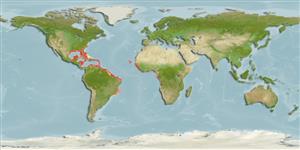>
Holocentriformes (Squirrelfishes, soldierfishes) >
Holocentridae (Squirrelfishes, soldierfishes) > Holocentrinae
Etymology: Holocentrus: Greek, holos = full + Greek, kentron = sting (Ref. 45335).
Environment: milieu / climate zone / depth range / distribution range
Ecologia
marinhas associadas(os) a recifes; intervalo de profundidade 0 - 180 m (Ref. 26938), usually 8 - 30 m (Ref. 3156). Subtropical; 37°N - 25°S, 97°W - 13°E
Western Atlantic: North Carolina, USA and Bermuda to Brazil, including the Gulf of Mexico and throughout the West Indies and Caribbean shores (Ref. 3724). Eastern Atlantic: Sao Tome Island and Gabon to Angola (Ref. 51178) and St. Paul's Rocks, St. Helena and Ascension Island (Ref. 6537).
Comprimento de primeira maturação / Tamanho / Peso / Idade
Maturity: Lm 14.6 range ? - 16.64 cm
Max length : 61.0 cm TL macho/indeterminado; (Ref. 3634); common length : 25.0 cm TL macho/indeterminado; (Ref. 5217)
Espinhos dorsais (total): 11; Raios dorsais (total): 15-16; Espinhos anais 4; Raios anais : 9 - 10. Tip of membranes of spinous dorsal fin reddish or translucent, not whitish; posterior margin of upper jaw reaching posterior margin of pupil (Ref. 13608). Spiny and soft parts of dorsal fin nearly separate, but connected by low membrane (Ref. 26938). Dull red or pinkish, sometimes blotched (Ref. 7251).
Occurs in shallow coral reefs, as well as deeper offshore waters (Ref. 3724). A nocturnal species, hiding in deep crevices or under coral ledges during the day; at night it usually moves over sand and grass beds, taking mainly crabs and other small crustaceans (Ref. 3634). Capable of producing sounds (Ref. 6537). Spawning documented as far north as North Carolina in May (Ref. 27549). Marketed fresh (Ref. 3724).
Ciclo de vida ou comportamento de acasalamento
Maturidade | Reprodução | Desova | Ovos | Fecundidade | Larvas
Robins, C.R. and G.C. Ray, 1986. A field guide to Atlantic coast fishes of North America. Houghton Mifflin Company, Boston, U.S.A. 354 p. (Ref. 7251)
Status na Lista Vermelha da UICN (Ref. 130435)
Ameaça para os humanos
Reports of ciguatera poisoning (Ref. 30303)
Uso pelos humanos
Pescarias: pouco comercial; Aquário: Aquários públicos
Mais informação
ReferênciasAquaculturaPerfil para aquaculturaEstirpesGenéticaElectrophoresesHereditariedadeDoençasProcessamentoNutrientsConversão de massa
Ferramentas
Relatórios especiais
Baixar XML
Fontes da internet
Estimates based on models
Preferred temperature (Ref.
123201): 23.4 - 28, mean 26.1 °C (based on 472 cells).
Índice de diversidade filogenética (Ref.
82804): PD
50 = 0.7500 [Uniqueness, from 0.5 = low to 2.0 = high].
Bayesian length-weight: a=0.01622 (0.01297 - 0.02028), b=2.97 (2.91 - 3.03), in cm total length, based on LWR estimates for this species (Ref.
93245).
Nível Trófico (Ref.
69278): 3.1 ±0.3 se; based on diet studies.
Resiliência (Ref.
120179): médio(a), tempo mínimo de duplicação da população 1,4 - 4,4 anos (Preliminary K or Fecundity.).
Fishing Vulnerability (Ref.
59153): Moderate vulnerability (44 of 100).
Nutrients (Ref.
124155): Calcium = 21.1 [9.3, 54.2] mg/100g; Iron = 0.544 [0.219, 1.093] mg/100g; Protein = 19.2 [18.0, 20.3] %; Omega3 = 0.231 [0.095, 0.539] g/100g; Selenium = 23.2 [12.7, 44.7] μg/100g; VitaminA = 30.6 [10.8, 90.6] μg/100g; Zinc = 0.719 [0.446, 1.132] mg/100g (wet weight);
